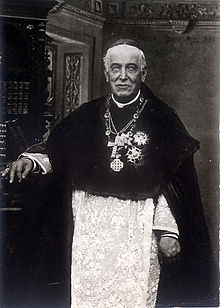Pelagio Antonio de Labastida y Dávalos
Pelagio Antonio de Labastida y Dávalos (born March 21, 1816 in Zamora , † February 4, 1891 in Oacalco in Yautepec de Zaragoza , Morelos ) was a Mexican clergyman of the 19th century, Archbishop of Mexico from March 18, 1863 until his death , also lawyer, doctor of canon law and politician. Pelagio Antonio de Labastida y Dávalos was a member of the imperial reign (from June 18, 1863 to November 17, 1863) that ruled Mexico and invited Archduke Ferdinand Maximilian of Austria to the throne of Mexico.
Spiritual career
In 1830 Labastida entered the seminary in Morelia , where he later became professor and director. His classmates included Clemente de Jesús Munguía y Núñez , later Archbishop of Michoacán, and Melchor Ocampo , later Foreign Minister.
Labastida was ordained a priest on November 10, 1839 . He quickly became known as a conservative orator , preacher against liberal and democratic ideas, and an adversary of the Freemasons . In 1854 he became a canon in Morelia . Labastida defied the doctrines of the liberals Melchor Ocampo and Miguel Lerdo de Tejada and treated them as heretics .
On March 23, 1855, he was appointed Bishop of Tlaxcala . After the victory of the conservatives under Antonio López de Santa Anna , the Bishop of Michoacán , Clemente de Jesús Munguía y Núñez , donated him the episcopal ordination on July 8, 1855 in the Cathedral of Mexico City . In December 1855 he supported the rebellion of Antonio Haro y Tamariz with finances for the diocese , because the federal government had ordered the sale of all goods in the diocese.
After the liberals returned to power in 1857, Labastida went into exile in Europe, where he contemplated the overthrow of the liberal government. After the Conservatives came back to power, he was invited by General Miguel Miramón to return to Mexico. Labastida later went into exile again. In 1862 he visited Archduke Ferdinand Maximilian of Austria in Trieste . At the beginning of 1863 he met Pope Pius IX. On March 18, 1863, Pius IX appointed Labastida as Archbishop of Mexico .
intervention
- Main article: French intervention in Mexico
On June 10, 1863, French troops arrived in the Mexican capital, and General Élie-Frédéric Forey convened a council of nobles to lay the foundations for a Mexican Empire . It remained only to determine to whom the crown should be bestowed. Labastida was the one who proposed Archduke Ferdinand Maximilian of Austria , whose election was also unanimously acclaimed.
On June 21, 1863, Labastida was chosen to reign by the Council of Nobles together with Juan Nepomuceno Almonte and José Mariano Salas . The triumvirate sent a delegation to Europe to offer the crown to Maximilian of Austria. Labastida was deposed on November 17, 1863 because of a dispute with François-Achille Bazaine , the commander of the French troops, because Bazaine tried to enforce the Napolénonic program regarding ecclesiastical goods. Juan Bautista de Ormaechea , the bishop of Tulancingo , was his successor. Likewise, his relationship with Maximilian deteriorated when the latter proclaimed freedom of religion. Pelagio Antonio de Labastida y Dávalos wrote, referring to ecclesiastical goods, that the representatives of the oligarchy are indifferent to the loss of ecclesiastical wealth or even support it, thereby destroying the protective wall that hides them.
After the end of the empire and the introduction of the republic in 1867, Labastida returned to Europe without resigning from his office as archbishop. In this capacity, Pelagio Antonio de Labastida y Dávalos participated in the First Vatican Council 1869–70. In 1871, President Benito Juárez allowed him to return to his country.
Individual evidence
- ↑ The reign was a triumvirate consisting of Juan Nepomuceno Almonte , José Mariano Salas and Pelagio Antonio de Labastida y Dávalos.
- ^ Burton Kirkwood: The History of Mexico. Greenwood Press, Westport CT et al. 2000, ISBN 0-313-30351-7 , pp. 100, 107.
- ^ [ Entry on Pelagio Antonio de Labastida y Dávalos on catholic-hierarchy.org ], accessed on September 7, 2014
- ↑ Церковь и олигархия в Латинской Америке , Иосиф Ромуальдович Григулевич , стр. 101 (Russian)
Web links
| predecessor | Office | successor |
|---|---|---|
| José María Luciano Becerra y Jiménez |
Bishop of Tlaxcala 1855–1863 |
Carlos María Colina y Rubio |
| José Lázaro de la Garza y Ballesteros |
Archbishop of Mexico 1863–1891 |
Próspero María Alarcón y Sánchez de la Barquera |
| personal data | |
|---|---|
| SURNAME | Labastida y Dávalos, Pelagio Antonio de |
| BRIEF DESCRIPTION | Mexican clergyman and archbishop |
| DATE OF BIRTH | March 21, 1816 |
| PLACE OF BIRTH | Zamora |
| DATE OF DEATH | February 4, 1891 |
| Place of death | Oacalco, Yautepec de Zaragoza , Morelos |

